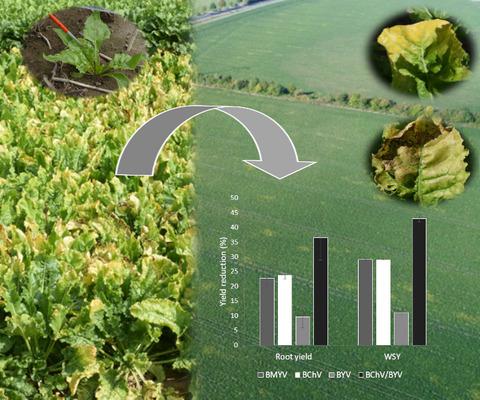当前位置:
X-MOL 学术
›
Plant Pathol.
›
论文详情
Our official English website, www.x-mol.net, welcomes your
feedback! (Note: you will need to create a separate account there.)
New insights into virus yellows distribution in Europe and effects of beet yellows virus, beet mild yellowing virus, and beet chlorosis virus on sugar beet yield following field inoculation
Plant Pathology ( IF 2.3 ) Pub Date : 2020-10-29 , DOI: 10.1111/ppa.13306 Roxana Hossain 1 , Wulf Menzel 2 , Celin Lachmann 1 , Mark Varrelmann 1
Plant Pathology ( IF 2.3 ) Pub Date : 2020-10-29 , DOI: 10.1111/ppa.13306 Roxana Hossain 1 , Wulf Menzel 2 , Celin Lachmann 1 , Mark Varrelmann 1
Affiliation

|
Beet yellows virus (BYV), beet mild yellowing virus (BMYV), beet chlorosis virus (BChV), and beet mosaic virus (BtMV) cause virus yellows (VY) disease in sugar beet. The main virus vector is the aphid Myzus persicae. Due to efficient vector control by neonicotinoid seed treatment over the last decades, there is no current knowledge regarding virus species distribution. Therefore, Europe‐wide virus monitoring was carried out from 2017 to 2019, where neonicotinoids were banned in 2019. The monitoring showed that closterovirus BYV is currently widely spread in northern Europe. The poleroviruses BMYV and BChV were most frequently detected in the northern and western regions. The potyvirus BtMV was only sporadically detected. To study virus infestation and influence on yield, viruses were transmitted to sugar beet plants using viruliferous M. persicae in quadruplicate field plots with 10% inoculation density simulating natural infection. A plant‐to‐plant virus spread was observed within 4 weeks. A nearly complete infection of all plants was observed in all treatments at harvest. In accordance with these findings, a significant yield reduction was caused by BMYV and BChV (−23% and −24%) and only a moderate reduction in yield was observed for BYV (−10%). This study showed that inoculation at low densities mimics natural infection, and quick spreading induced representative yield effects. Within the background of a post‐neonicotinoid era, this provides the basis to screen sugar beet genotypes for the selection of virus tolerance/resistance and to test the effectiveness of insecticides for the control of M. persicae with a manageable workload.
中文翻译:

对欧洲病毒黄变的新见解以及田间接种后甜菜黄病毒,甜菜轻度泛黄病毒和甜菜绿化病毒对甜菜产量的影响
甜菜黄病毒(BYV),甜菜轻度泛黄病毒(BMYV),甜菜绿化病毒(BChV)和甜菜花叶病毒(BtMV)引起甜菜中的病毒黄(VY)病。主要病毒载体是蚜虫桃蚜。由于在过去的几十年中通过新烟碱种子处理对载体进行了有效控制,因此目前尚无关于病毒种类分布的知识。因此,从2017年至2019年在欧洲范围内进行了病毒监测,其中在2019年禁止了新烟碱类药物。监测表明,梭状病毒BYV目前在北欧广泛传播。极地病毒BMYV和BChV在北部和西部地区最常见。只是偶尔检测到了potyvirus BtMV。为了研究病毒侵染和对产量的影响,使用有毒M将病毒传播到甜菜植物。波斯菊在接种密度为10%的一式四份田地中模拟自然感染。在4周内观察到了植物间病毒传播。在收获时的所有处理中均观察到所有植物的近乎完全感染。根据这些发现,BMYV和BChV导致产量大幅下降(-23%和-24%),而BYV仅观察到中等程度的产量下降(-10%)。这项研究表明,低密度接种可模拟自然感染,并且快速传播可引起代表性的增产效应。在后新烟碱时代的背景下,这为筛选甜菜基因型选择病毒耐性/抗性和测试杀虫剂控制M的有效性提供了基础。波斯菊 具有可管理的工作量。
更新日期:2020-10-29
中文翻译:

对欧洲病毒黄变的新见解以及田间接种后甜菜黄病毒,甜菜轻度泛黄病毒和甜菜绿化病毒对甜菜产量的影响
甜菜黄病毒(BYV),甜菜轻度泛黄病毒(BMYV),甜菜绿化病毒(BChV)和甜菜花叶病毒(BtMV)引起甜菜中的病毒黄(VY)病。主要病毒载体是蚜虫桃蚜。由于在过去的几十年中通过新烟碱种子处理对载体进行了有效控制,因此目前尚无关于病毒种类分布的知识。因此,从2017年至2019年在欧洲范围内进行了病毒监测,其中在2019年禁止了新烟碱类药物。监测表明,梭状病毒BYV目前在北欧广泛传播。极地病毒BMYV和BChV在北部和西部地区最常见。只是偶尔检测到了potyvirus BtMV。为了研究病毒侵染和对产量的影响,使用有毒M将病毒传播到甜菜植物。波斯菊在接种密度为10%的一式四份田地中模拟自然感染。在4周内观察到了植物间病毒传播。在收获时的所有处理中均观察到所有植物的近乎完全感染。根据这些发现,BMYV和BChV导致产量大幅下降(-23%和-24%),而BYV仅观察到中等程度的产量下降(-10%)。这项研究表明,低密度接种可模拟自然感染,并且快速传播可引起代表性的增产效应。在后新烟碱时代的背景下,这为筛选甜菜基因型选择病毒耐性/抗性和测试杀虫剂控制M的有效性提供了基础。波斯菊 具有可管理的工作量。











































 京公网安备 11010802027423号
京公网安备 11010802027423号